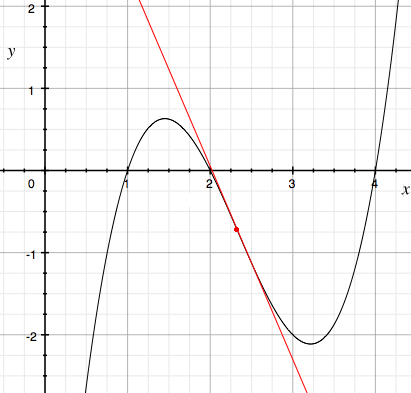|
Solution for April 2013
| The Problem: |
 |
Find all pairs $c$ and $d$ of real numbers such that all roots of the polynomials
$$6x^2-24x-4c \quad \mbox{ and } \quad x^3 +cx^2 +dx - 8$$
are nonnegative real numbers.
Answer. There exists a single pair of values for which all roots are nonnegative and real, namely $c = -6, d=12$.
Lamis Alsheikh
(Syria) |
Diana Andrei
(Sweden) |
Jose Arraiz
(France) |
Ricardo Bernabé Baloni (Argentina) |
Aleksandar Blazhevski
(Macedonia) |
Radouan Boukharfane
(Québec) |
Lou Cairoli
(USA) |
Bernard Carpentier (France) |
Allen Druze
(USA) |
Edgardo Figueroa Donayre |
Jan Fricke
(Germany) |
Georges Ghosn
(Québec) |
Tony Harrison
(UK) |
Kipp Johnson
(USA) |
Matthew Lim
(USA) |
Patrick J. LoPresti
(USA) |
Nawal Kishor Mishra (India) |
Luis Rivera |
| Albert Stadler (Switzerland) |
Bruno Tisserand
(France) |
|
We also received three solutions that were incomplete and one that was incorrect.
|
The solution:
When $c=-6$ and $d=12$ the polynomials become $6(x-2)^2$ and $(x-2)^3$, whence all five roots coincide at $x=2$ and are thereby nonnegative and real. We must now show that there are no further satisfactory pairs. Everybody's first step was to consider the quadratic $f(x) := 6x^2-24x-4c$ and show that for its roots to be real we must have $c \ge -6$: either note that its discriminant is $24^2-4\cdot 6 \cdot (-4c) = 96(6+c)$, which is nonnegative exactly when $c \ge -6$; or write $f(x) = 6(x-2)^2 -4(c+6)$ and note that its minimum is $-4(c+6)$ at $x=2$, which is below the $x$-axis when $c \ge -6$. (The requirement that the roots of $f(x)$ be nonnegative is not required; this extra condition forces $c \le 0$, but we shall soon see that the given cubic is more restrictive.)
To analyze the cubic we have a choice of using calculus or using the inequality of arithmetic and geometric means.
The AM-GM inequality. If $r,s$, and $t$ are the roots of the cubic we have
$$g(x) := x^3 +cx^2 +dx - 8 = (x-r)(x-s)(x-t).$$
Comparing coefficients yields $r+s+t = -c$ and $rst = 8$. To apply the AM-GM inequality we must make use of the requirement that the roots be nonnegative; in fact, they are positive (because their product is 8). The inequality tells us that any three positive numbers $r,s,t$ satisfy
$$r+s+t \ge 3\sqrt[3]{rst},$$
whence $-c \ge 6$; that is, $c \le -6$. But we earlier determined that $c\ge -6$, from which we deduce that $c = -6$. It quickly follows that $r+s+t = 6 = 3\sqrt[3]{rst}$; therefore $r=s=t=2$ and $d=12$. Consequently, $c = -6, d=12$ is the only pair satisfying the given conditions.
A calculus argument. The submissions that avoided the AM-GM inequality all used calculus to some extent. Here is how Harrison argued. Because the second derivative is $g''(x) = 6x+2c$, the cubic curve $y=g(x) = x^3 +cx^2 +dx - 8$ has a point of inflection at $\left(-\frac13c, \; \frac2{27}c^3-\frac13cd-8\right)$ (where the second derivative is zero). Because $g'\left(-\frac13c\right) = d-\frac13c^2$, the line tangent to the curve at its inflection point has the equation
$$y-\left(\frac2{27}c^3-\frac13cd-8\right) = \left(d-\frac13c^2\right)\left(x+\frac13c\right),
\quad \mbox{ or }$$ $$ y= \left(d-\frac13c^2\right)x -\left(\frac1{27}c^3 + 8\right); $$
it therefore intersects the $y$-axis where $y=-\left(\frac1{27}c^3 + 8\right)$. Because we know that $c \ge -6$, we deduce that the $y$-intercept is at most $\left(\frac1{27}(-6)^3 + 8\right) = 0$. But we know that for our cubic $g(x)$ to have distinct positive roots, it must attain its relative maximum for some value of $x$ between $x=0$ and the inflection point, as in the accompanying diagram. Moreover, this maximum must lie below the line that is tangent to the curve at its inflection point; but we know that the inflectional tangent must have a negative slope, and we have seen that it lies below the positive $x$-axis, thus preventing the the curve from meeting the positive $x$-axis to the left of the inflection point. We are therefore led to conclude that the inflectional tangent must coincide with the $x$-axis. This forces $\frac1{27}c^3 + 8 = 0$ and, therefore, $c=-6$. Finally, the slope of the tangent, namely $d-\frac13c^2$, must be 0, so that $d = 12$, as claimed.

The graph of a cubic curve that has distinct positive roots,
shown with its inflectional tangent.
Acknowledgment. Our April problem was \#4 on the Estonian International Mathematical Olympiad Selection Contest 2004-2005. See Crux Mathematicorum 35:1 (February 2009) page 28.
|

